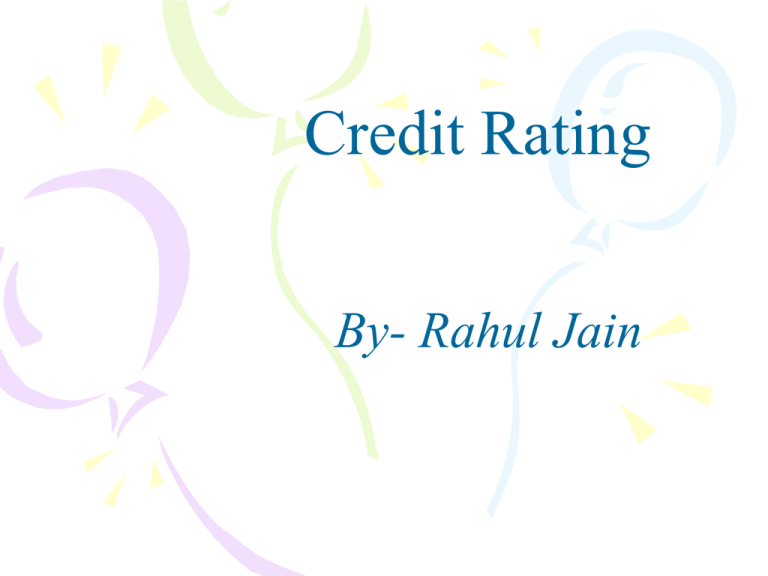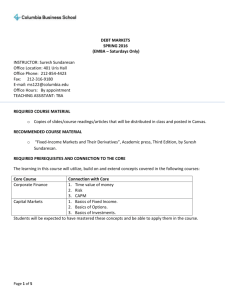creditrating - Learning Financial Management
advertisement

Credit Rating By- Rahul Jain What is a credit rating? A credit rating is an opinion on the relative degree of risk associated with timely payment of interest and principal on a debt instrument. A simple alphanumeric symbol is normally used to convey a credit rating. 4/13/2015 2 Credit rating is an input for decision making A credit rating is not a recommendation to buy, hold or sell a debt instrument. A rating is one of the inputs that is used by investors to make an investment decision. Investors also look at the returns being offered on the debt instrument. Normally investors expect higher returns for lower rated instruments to compensate for the increased risk profile. Rating agencies do not comment on the return being offered on a debt instrument. Also, investors use several other factors like level of portfolio diversification and liquidity levels of the instrument etc. in making investment decisions. 4/13/2015 3 Need of Credit rating SOURCE OF FUNDS Depositors USE OF FUNDS Bank Borrowers Bank provides liquidity Bank assumes credit risk Bank undertakes credit assessments 4/13/2015 4 Need of Credit rating SOURCE OF FUNDS Investors 4/13/2015 MARKET USE OF FUNDS Issuers Market provides liquidity Investors assume credit risk Credit rating service provides measure of credit risk 5 Asian Debt Market Activity - 2002 Aggregate of Cross-Border Bond, Domestic Bond and Loan Market US$ (m) 40,000 35,000 Total Debt Market Domestic Bonds 30,000 25,000 20,000 15,000 10,000 5,000 0 H 4/13/2015 g on K g on na i Ch d ia ia es re n s s o n a y i iw il a ne p ap l a a p o a g i h T n il T nd M h I Si P an ia d In n si ta k Pa Source Thomson Financial 6 Issues 1. Transparency and disclosure 2. Protection of creditor rights 3. Global scale vs National scale 4/13/2015 7 SEBI-Regulator The capital market regulator regulates rating agencies in most regions. In India, the capital markets regulator, the Securities and Exchange Board of India (SEBI), regulates the rating agencies in the country. SEBI laid down an extensive set of regulations for rating agencies in 1999. 4/13/2015 8 Why do ratings change? Ratings are assigned based on certain expectations and assumptions about variables that impact the issuer’s performance. These variables are either company-specific factors or factors relating to the business environment. Rating agencies use their best professional judgment on these factors while assigning the rating. However, these variables can change significantly over a relatively short time-frame, especially in emerging markets, causing the rated entities’ performance to deviate materially from expectations. This changes their future debt repayment capabilities and is reflected in their changed ratings. 4/13/2015 9 Rating Process 4/13/2015 10 Global Vs. National Rating Scales National Scale Global Scale • Include relevant sovereign and country risk considerations • • Creditworthiness based on a global comparative analysis • • Both foreign and local currency credit options • 4/13/2015 Exclude direct sovereign risks of other country risk factors that affect all local obligators Relative creditstanding within a given country Local currency credit opinions 11 Standard & Poor’s Asia-Pacific Network – 2003 Standard & Poor’s * Hong Kong Melbourne Seoul Singapore Sydney Tokyo * Staff - 320 Affiliates CRISIL (Mumbai) PEFINDO (Jakarta) PhilRatings (Manila) TRC (Taipei) 4/13/2015 12 Average Cumulative15-Year Default Rates (%) 70 60.70 60 50 27.83 40 30 24.51 20 4.27 10 0.67 1.30 2.30 0 AAA Source: Standard & Poor’s AA A BBB BB B CCC









